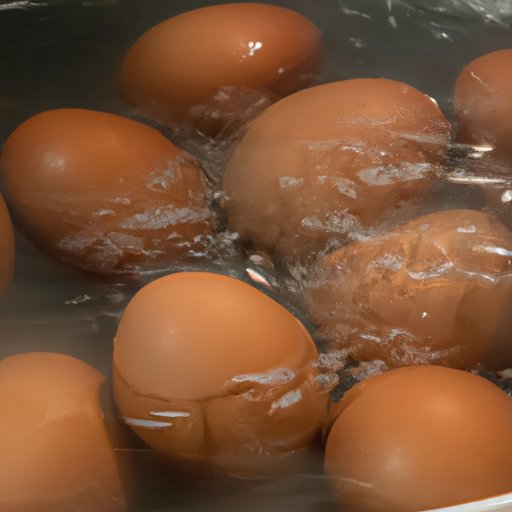
Introduction
Boiling eggs can be a tricky task, especially when it comes to knowing exactly when they’re done. Nobody wants to end up with a slimy, undercooked yolk or a rubbery, overcooked one. With so many different methods available, it can be hard to know which one to use. In this article, we’ll explore several popular methods for determining when your eggs are done boiling.
Using The Timer Method
The timer method is perhaps the most popular way to boil eggs to different levels of doneness. Here’s how to do it:
- Place your eggs in a pot and cover them with cold water.
- Bring the water to a boil over medium-high heat.
- Once the water has reached a rolling boil, turn off the heat and cover the pot.
- Set a timer for the desired level of doneness: 4 minutes for soft-boiled, 6 minutes for medium-boiled, and 10-12 minutes for hard-boiled.
- Once the timer goes off, immediately transfer the eggs to a bowl of ice water to stop the cooking process.
Adjusting the cooking time based on factors like egg size or altitude can help ensure that your eggs come out perfectly boiled every time.
The Water Test Method
The water test method involves carefully placing an egg in a pot of boiling water and observing how it behaves. Here’s how to do it:
- Bring a pot of water to a rolling boil.
- Carefully lower an egg into the water using a slotted spoon.
- Observe the egg to determine the level of doneness: a floating egg with a white, opaque appearance is fully cooked, while an egg that sinks to the bottom of the pot and has a more translucent appearance is not yet done.
- Remove the egg from the pot once you’ve determined its doneness level.
While this method can be helpful for getting a rough idea of your egg’s doneness level, it’s not always accurate and can be more difficult to get right.
The Spoon Method
The spoon method involves using a spoon to examine the sound and texture of a boiled egg. Here’s how to do it:
- Remove an egg from the pot and gently tap it with a spoon.
- Listen to the sound it makes: a higher-pitched sound indicates that the egg is more well-done, while a lower-pitched sound means it’s less cooked.
- Examine the texture of the egg by touching it with the spoon: a harder texture means the egg is more well-done, while a softer texture means it’s less cooked.
- Use these observations to determine the egg’s doneness level and adjust your cooking time accordingly.
While this method can be helpful for getting a sense of your egg’s doneness level, it’s harder to get right and may not be as accurate as some of the other methods.
The Crack Test Method
The crack test method is a visual way to determine the level of doneness of your boiled egg. Here’s how to do it:
- Carefully remove an egg from the pot and place it on a plate or chopping board.
- Use a knife or spoon to crack the egg open and observe the consistency of the yolk and white.
- A more runny yolk and liquid white means that the egg is less well-done, while a more solid yolk and firm white means it’s more well-done.
- Use these observations to adjust your cooking time and achieve your desired level of doneness.
This method can be helpful if you want to check the doneness of your eggs but don’t necessarily want to eat them right away.
The Fridge Method
The fridge method involves storing boiled eggs in the fridge until they’re completely cooled down and ready to eat. Here’s how to do it:
- Boil your eggs using the preferred method.
- Transfer the eggs to a bowl of ice water to cool them down completely.
- Store the eggs in the fridge for at least an hour, or up to several days.
- When you’re ready to eat the eggs, simply remove them from the fridge and peel them as desired.
This method can be helpful for ensuring that your boiled eggs are completely cooked and ready to eat, without having to worry about overcooking them or undercooking them.
Conclusion
Boiling eggs may seem daunting, but with the right method and a little bit of practice, you’ll be able to achieve perfect eggs every time. Whether you prefer the timer method, the water test, spoon test, the crack test, or the fridge method, each one has its pros and cons, and it’s up to you to decide which one works best for your preferences. Just remember that practice makes perfect, and don’t be afraid to experiment until you find the perfect boiled egg.




